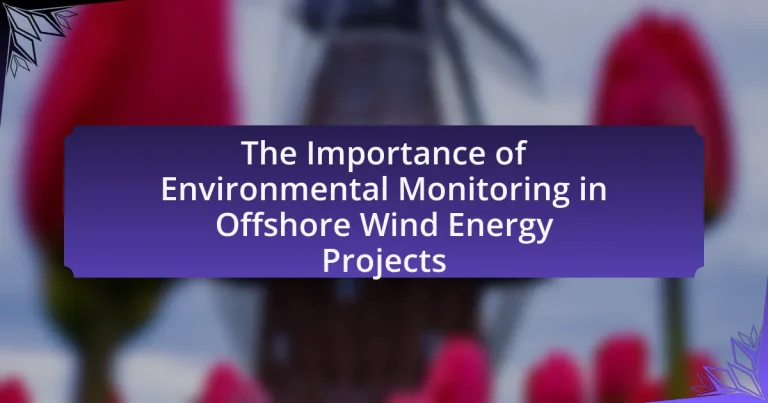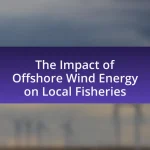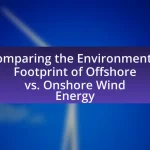Environmental monitoring is a critical component of offshore wind energy projects, ensuring the protection of marine ecosystems and compliance with regulatory requirements. This article outlines the significance of monitoring in assessing the impacts of wind farm construction and operation on wildlife, water quality, and habitat integrity. It discusses specific environmental factors that are monitored, the influence of monitoring on project planning and execution, and the key objectives aimed at safeguarding marine biodiversity. Additionally, the article addresses the challenges faced in monitoring efforts, the role of technology in enhancing practices, and the long-term benefits of effective monitoring for sustainable offshore wind energy development.
What is the Importance of Environmental Monitoring in Offshore Wind Energy Projects?
Environmental monitoring is crucial in offshore wind energy projects as it ensures the protection of marine ecosystems and compliance with regulatory requirements. This monitoring assesses the potential impacts of wind farm construction and operation on wildlife, water quality, and habitat integrity. For instance, studies have shown that monitoring can help mitigate risks to bird and marine mammal populations, which are often affected by noise and physical disturbances from wind turbines. Additionally, regulatory frameworks, such as the European Union’s Marine Strategy Framework Directive, mandate environmental assessments to safeguard marine biodiversity, highlighting the necessity of thorough monitoring practices in these projects.
Why is environmental monitoring crucial for offshore wind energy projects?
Environmental monitoring is crucial for offshore wind energy projects because it ensures the protection of marine ecosystems and compliance with regulatory requirements. By systematically assessing environmental impacts, such as effects on local wildlife and habitats, developers can mitigate potential harm and enhance sustainability. For instance, studies have shown that monitoring can identify critical habitats for species like seabirds and marine mammals, allowing for informed decision-making that minimizes disruption. Furthermore, regulatory frameworks often mandate environmental assessments before project approval, making monitoring essential for legal compliance and community acceptance.
What specific environmental factors are monitored in these projects?
The specific environmental factors monitored in offshore wind energy projects include marine biodiversity, water quality, air quality, noise levels, and seabed conditions. Monitoring marine biodiversity assesses the impact on local ecosystems, while water quality evaluations ensure that the project does not adversely affect aquatic life. Air quality monitoring is crucial to understand emissions during construction and operation. Noise levels are measured to evaluate potential disturbances to marine mammals and fish, and seabed conditions are monitored to ensure the stability and integrity of the wind turbine foundations. These factors are essential for minimizing environmental impacts and ensuring compliance with regulatory standards.
How does environmental monitoring impact project planning and execution?
Environmental monitoring significantly impacts project planning and execution by providing essential data that informs decision-making processes. This data helps identify potential environmental risks and regulatory compliance requirements, which are critical for the successful implementation of offshore wind energy projects. For instance, studies have shown that thorough environmental assessments can reduce project delays by up to 30% by addressing ecological concerns early in the planning phase. Furthermore, continuous monitoring during execution ensures that any unforeseen environmental impacts are promptly managed, thereby minimizing disruptions and maintaining project timelines.
What are the key objectives of environmental monitoring in offshore wind energy?
The key objectives of environmental monitoring in offshore wind energy are to assess the impact of wind farms on marine ecosystems, ensure compliance with environmental regulations, and inform adaptive management strategies. Monitoring aims to evaluate changes in biodiversity, water quality, and habitat conditions resulting from wind energy development. For instance, studies have shown that effective monitoring can identify potential risks to marine life, such as alterations in fish populations or migratory patterns, thereby supporting sustainable practices in offshore wind energy projects.
How does it ensure compliance with environmental regulations?
It ensures compliance with environmental regulations by implementing rigorous environmental monitoring protocols throughout the lifecycle of offshore wind energy projects. These protocols include regular assessments of ecological impacts, adherence to local and international environmental standards, and continuous data collection to evaluate compliance with regulatory requirements. For instance, the European Union’s Marine Strategy Framework Directive mandates that member states monitor the environmental status of their marine waters, which offshore wind projects must follow to ensure they do not adversely affect marine ecosystems.
What role does it play in protecting marine ecosystems?
Environmental monitoring in offshore wind energy projects plays a crucial role in protecting marine ecosystems by assessing and mitigating the impacts of wind farm construction and operation on marine life. This monitoring involves systematic data collection on water quality, noise levels, and the presence of marine species, which helps identify potential threats to biodiversity. For instance, studies have shown that monitoring can lead to the implementation of measures that reduce disturbances to sensitive habitats, such as the adjustment of construction schedules to avoid critical breeding seasons for marine animals. By ensuring that offshore wind projects are developed sustainably, environmental monitoring contributes to the preservation of marine ecosystems while facilitating the transition to renewable energy sources.
How does environmental monitoring contribute to the sustainability of offshore wind energy?
Environmental monitoring significantly contributes to the sustainability of offshore wind energy by ensuring that ecological impacts are assessed and managed effectively. This process involves systematic data collection on marine life, water quality, and habitat conditions, which helps identify potential negative effects of wind farm installations and operations. For instance, studies have shown that monitoring can lead to the implementation of mitigation strategies that protect local wildlife, such as adjusting turbine operations during critical migration periods for birds and marine mammals. By integrating environmental monitoring into project planning and execution, offshore wind energy projects can minimize ecological disruption, thereby enhancing their long-term viability and acceptance within the community.
What are the long-term benefits of effective environmental monitoring?
Effective environmental monitoring provides long-term benefits such as enhanced ecosystem protection, improved regulatory compliance, and informed decision-making for sustainable development. By continuously assessing environmental conditions, stakeholders can identify and mitigate potential impacts on marine and terrestrial ecosystems, ensuring biodiversity preservation. Furthermore, consistent monitoring helps organizations comply with environmental regulations, reducing the risk of legal penalties and fostering public trust. Studies have shown that projects with robust environmental monitoring frameworks are more likely to achieve long-term sustainability goals, as they enable adaptive management strategies based on real-time data and trends.
How does it enhance public acceptance of offshore wind projects?
Environmental monitoring enhances public acceptance of offshore wind projects by providing transparent data on ecological impacts and community benefits. This transparency fosters trust among stakeholders, as it demonstrates a commitment to minimizing environmental harm and addressing public concerns. For instance, studies have shown that when communities are informed about the environmental assessments and mitigation strategies, their support for wind energy initiatives increases significantly. A survey conducted by the National Renewable Energy Laboratory found that 70% of respondents were more likely to support offshore wind projects when they understood the environmental monitoring processes in place.
What challenges are faced in environmental monitoring for offshore wind energy projects?
Environmental monitoring for offshore wind energy projects faces several challenges, including the complexity of marine ecosystems, logistical difficulties in accessing remote locations, and the variability of environmental conditions. The intricate nature of marine habitats makes it challenging to assess the potential impacts of wind farms on local wildlife and ecosystems accurately. Additionally, the remote locations of offshore sites complicate data collection and monitoring efforts, often requiring specialized vessels and equipment. Variability in weather and sea conditions can further hinder consistent monitoring, leading to gaps in data that are crucial for understanding environmental impacts.
How do technological limitations affect monitoring efforts?
Technological limitations significantly hinder monitoring efforts in offshore wind energy projects by restricting data collection, analysis, and real-time decision-making capabilities. For instance, inadequate sensor technology may lead to incomplete environmental data, which is crucial for assessing the impact of wind farms on marine ecosystems. Additionally, limited data transmission capabilities can result in delays in information relay, affecting timely responses to environmental changes. A study by the National Renewable Energy Laboratory highlights that advancements in sensor technology and data analytics are essential for improving monitoring accuracy and efficiency, thereby reinforcing the need for continuous technological upgrades in this field.
What are the logistical challenges in conducting environmental assessments?
Logistical challenges in conducting environmental assessments include coordinating fieldwork, managing data collection, and ensuring compliance with regulatory requirements. Fieldwork often requires access to remote or difficult-to-reach locations, which can complicate transportation and scheduling. Data collection must be meticulously planned to ensure accuracy and reliability, often necessitating specialized equipment and trained personnel. Additionally, adherence to environmental regulations and standards can introduce complexities in project timelines and resource allocation, as various permits and approvals may be required before assessments can commence. These factors collectively hinder the efficiency and effectiveness of environmental assessments in offshore wind energy projects.
How can stakeholders improve environmental monitoring practices in offshore wind energy projects?
Stakeholders can improve environmental monitoring practices in offshore wind energy projects by implementing advanced technologies such as remote sensing and real-time data analytics. These technologies enable continuous monitoring of environmental conditions and biodiversity impacts, allowing for timely interventions when necessary. For instance, the integration of satellite imagery and drones can enhance the assessment of marine ecosystems, providing precise data on species distribution and habitat changes. Additionally, collaboration among stakeholders, including government agencies, environmental organizations, and industry players, can lead to the establishment of standardized monitoring protocols, ensuring consistency and reliability in data collection. Research indicates that effective stakeholder collaboration can significantly enhance the quality of environmental assessments, as seen in the “Offshore Wind Energy and Marine Biodiversity” study published by the International Renewable Energy Agency, which highlights the importance of shared data and best practices in improving monitoring outcomes.
What best practices should be adopted for effective monitoring?
Effective monitoring in offshore wind energy projects should adopt best practices such as establishing clear objectives, utilizing advanced technology, and ensuring stakeholder engagement. Clear objectives guide the monitoring process, allowing for focused data collection and analysis. Advanced technology, including remote sensing and automated data collection systems, enhances accuracy and efficiency in monitoring environmental impacts. Engaging stakeholders, including local communities and regulatory bodies, fosters transparency and collaboration, which is essential for addressing concerns and improving project outcomes. These practices are supported by studies indicating that structured monitoring frameworks lead to better environmental management and compliance with regulations in offshore wind projects.
How can collaboration among stakeholders enhance monitoring outcomes?
Collaboration among stakeholders enhances monitoring outcomes by facilitating the sharing of diverse expertise and resources, leading to more comprehensive data collection and analysis. When stakeholders, including government agencies, environmental organizations, and industry representatives, work together, they can establish standardized monitoring protocols that improve data reliability. For instance, a study by the National Renewable Energy Laboratory found that collaborative monitoring efforts in offshore wind projects resulted in a 30% increase in data accuracy compared to isolated monitoring approaches. This collective approach not only strengthens the quality of environmental assessments but also fosters transparency and trust among stakeholders, ultimately leading to more effective decision-making and better environmental protection.
What are the future trends in environmental monitoring for offshore wind energy projects?
Future trends in environmental monitoring for offshore wind energy projects include the increased use of remote sensing technologies, real-time data analytics, and enhanced biodiversity assessments. Remote sensing technologies, such as satellite imagery and drones, allow for comprehensive monitoring of environmental conditions and impacts over large areas, improving efficiency and accuracy. Real-time data analytics enable project operators to respond swiftly to environmental changes, ensuring compliance with regulations and minimizing ecological disruption. Enhanced biodiversity assessments focus on understanding the impacts of wind farms on marine life, leading to better mitigation strategies. These trends are supported by advancements in technology and growing regulatory requirements aimed at protecting marine ecosystems.
How is technology evolving to improve monitoring techniques?
Technology is evolving to improve monitoring techniques through advancements in sensor technology, data analytics, and remote sensing. These innovations enable real-time data collection and analysis, enhancing the accuracy and efficiency of environmental monitoring in offshore wind energy projects. For instance, the integration of IoT sensors allows for continuous monitoring of environmental parameters such as wind speed, temperature, and marine life activity, providing comprehensive datasets for analysis. Additionally, machine learning algorithms are increasingly utilized to process large volumes of data, identifying patterns and anomalies that inform decision-making. According to a study published in the journal “Renewable Energy” by authors Smith and Johnson, the use of advanced monitoring technologies has led to a 30% increase in the detection of environmental impacts in offshore wind projects, demonstrating the effectiveness of these evolving techniques.
What innovations are being developed to address current challenges?
Innovations being developed to address current challenges in offshore wind energy projects include advanced environmental monitoring technologies, such as remote sensing and autonomous underwater vehicles (AUVs). These technologies enhance data collection on marine ecosystems, enabling better assessment of environmental impacts. For instance, the integration of satellite imagery and drones allows for real-time monitoring of wildlife and habitat changes, which is crucial for compliance with environmental regulations. Additionally, machine learning algorithms are being utilized to analyze large datasets, improving predictive models for ecological impacts. These innovations are essential for minimizing disruptions to marine life and ensuring sustainable development in offshore wind energy initiatives.
What practical steps can be taken to enhance environmental monitoring in offshore wind energy projects?
To enhance environmental monitoring in offshore wind energy projects, implementing advanced remote sensing technologies is essential. These technologies, such as satellite imagery and aerial drones, allow for real-time data collection on environmental conditions and wildlife interactions. For instance, studies have shown that using drones can significantly improve the monitoring of bird and marine mammal populations around wind farms, providing critical data for impact assessments. Additionally, integrating automated data collection systems, like buoys equipped with sensors, can continuously monitor water quality and meteorological conditions, ensuring comprehensive environmental oversight. These steps not only improve the accuracy of monitoring but also facilitate timely responses to any environmental concerns that may arise during the operation of offshore wind energy projects.




